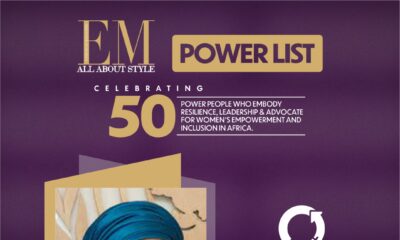Features
Bisola Alabi: Practical Tips for Stay-At-Home Mums Returning to the Workforce

A stay-at-home mum’s job is not as easy as it seems. Majority think it is a life of leisure, but that is far from the reality. Also, it does not help that the society looks down upon stay-at-home mums. You can see the smirks and the condescending look even though they try so hard to control it. We all know the choice to step back from your career path to become a stay-at-home mum must have been a hard choice to make; you may have taken a break to raise your child(ren) in their formative years or decided to try out a business idea or even had other reasons. Whatever your reason is, it is valid.
Now, you are contemplating a return to the workforce and that’s great! Although you miss the feeling of working, you are wondering how you will start interacting in a productive environment and challenging yourself, and the doubts are starting to creep in.
“I’ve been away for so long, can I still do the job?”
“All my peers are way ahead of me.”
“Everyone is going to laugh at me.”
“I’m not good enough.”
Hey, I understand how you feel; I was once in your shoes. I was a stay-at-home mum for 3 years and I totally understand your choices. So do a lot of global organizations at the moment. The COVID-19 pandemic has changed the global perspective on work-life balance – organisations now understand the challenges women face and have created return to work programs to make life easier for the 21st century woman. To digress a little, these programs would not have happened without female leadership. This further underscore the importance of having women in top managerial positions.
My experience as a stay-at-home mum has taught me that there are transferable and soft skills that can be learnt on the side and it isn’t as difficult as it might seem. These skills will make you valuable to recruiters. Research shows that that 93% of employers classify soft skills as either essential or very important when making hiring decisions. As a stay-at-home mum, you gain soft skills like compassion, empathy, patience, planning, and multitasking. You have the ability to seamlessly integrate tasks together. These soft skills are transferable, meaning that you could add them to your resume and apply them in your new job. Going back to work after staying at home may seem tough and you may also be feeling inadequate.
Here are 5 steps to take to ease your transition back into the workspace:
Think and strategize
Once you’ve made the decision to go back to work, the first step is to start making a clear plan. Ask yourself the following questions:
- Do I want to continue in my previous career path or switch career paths?
- Do I want to work full time or part time?
- Is working remotely or physically better for me?
- Am I going to be a freelancer or fulltime employee?
These are all important questions to ask. The answer to them will shape how you will go about the whole process of looking for a job. Take your time, research the pros and cons and evaluate them. You should also talk to your partner, friends and family if you need more clarity. My advice will be to go for the one that works best for you and will help you achieve your goals .
Upgrade your skills
Now let’s take a look at the option you picked in the first step. Did you decide to continue with your previous career path? If you did, you’ll need to upgrade your skills. If you try to enter the workforce with the same skill set as you previously had, it might be difficult to get a good job. The world has changed since you took a break, and you will need to take courses or programs to refresh your skills and give yourself a competitive advantage over others in the industry.
If you chose to go another career path, that’s equally great. There are great courses and programs available for learning new skills. If you cannot afford them, YouTube and Google are great tools for learning the basics. You can get a good job and subsequently upskill. You can learn a skill in 3-6 months by dedicating 4-6 hours daily studying and implementing.
Build a Personal Brand
You’ve got to promote yourself in a way that appeals to recruiters. What better way to do this than harnessing the power of social media. The LinkedIn app is a gold mine for anyone in the professional space. Position yourself as an expert in your industry, and create strategic content to attract recruiters attention. For instance, if you learnt software development, brand yourself as a product manager. If you are creative, use figma to create wireframes and prototypes for websites and brand yourself as a UI/UX designer. Have a digital footprint and samples to showcase your skill set and expertise. Update your social media profile and your resume to reflect your new skills.
Create a Good Resume and Prepare for Interviews
You should write your resume in a way that excludes timelines. This will cover up the gap in your working experience on your resume. If the question “Why were you not working for this period?” pops up in your interview, don’t panic or lie. instead, tell the interviewer the real reason you were not active. Then emphasise on the soft skills you gained (like empathy, multitasking) while at home, and how you can bring those skills into their organisation. Also, highlight how you upgraded your skills to stay up to date in the industry.
What you’re trying to do is take attention away from your staying away, and focus the attention on what you gained and how it will be of benefit to them. Every employer wants to know what you’re bringing to the table so if you do all the above, you’re showing them why they should bring you onboard.
Networking
Networking is key, especially after a career break. Carol Fishman Cohen, CEO and cofounder of iRelaunch (an organisation that helps women return to work) said, “The bottom line is that you can’t rely on blindly submitting resumes to job openings and expect to be successful.” Statistics show that 85% of jobs are landed through connections. You need all the help you can get. Strive to make useful connections and relationships with people. Look for ways to be of help to your connections and they are likely to also put your name forward and recommend you for positions that are not even made public.
You can also network amongst friends and family. Who knows, your connections will come through for you.
Keep an Open Mind
Don’t be close minded. Bear in mind that times have changed and there are so many amazing opportunities now that didn’t exist before. Keep an open mind even if the opportunity is one that you are not familiar with. There are opportunities everywhere. You need to know how to look for them and make use of them properly when you find them.
There are programs organised by global organisations with the aim of helping women transition back to the workforce. These programs will mentor, guide, and teach you new skills if need be. Such organisations include Facebook, IBM, HP, Goldman Sachs, Morgan Stanley, and Credit Suisse. Just go on their website, and the details on how to apply is available there.
Happy transitioning!
***
Photo by William Fortunato from Pexels






















